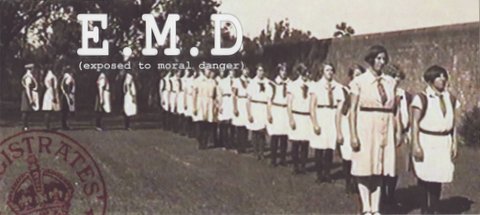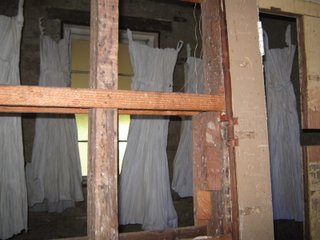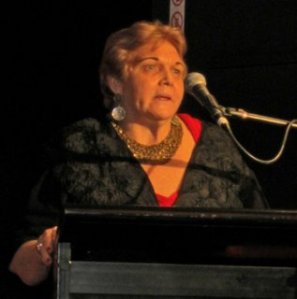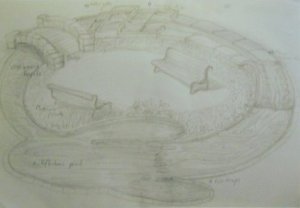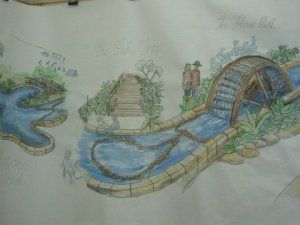 Thanks to the vision and passionate commitment of artist Bonney Djuric, the current exhibition Living Traces – a Parragirls artist book and print exhibition – is giving us a glimpse of possibilities both poignant and beautiful. The possibilities are implicit in her proposed International Site of Conscience embracing the convict Parramatta Female Factory and the Parramatta Girls Home. Both lie in the Parramatta North Heritage Precinct, a key site of Sydney’s colonial history from 1792 and part of the land of the Burramatta clan of the Darug people for at least 20,000 years.
Thanks to the vision and passionate commitment of artist Bonney Djuric, the current exhibition Living Traces – a Parragirls artist book and print exhibition – is giving us a glimpse of possibilities both poignant and beautiful. The possibilities are implicit in her proposed International Site of Conscience embracing the convict Parramatta Female Factory and the Parramatta Girls Home. Both lie in the Parramatta North Heritage Precinct, a key site of Sydney’s colonial history from 1792 and part of the land of the Burramatta clan of the Darug people for at least 20,000 years.
This core of Australia’s national history is now threatened with subdivision and development by the NSW Government through its agency UrbanGrowth. The girls home is currently under investigation as part of the Royal Commission into Institutional responses to Child Sexual Abuse and former individual male staff members are the subject of criminal investigations.
 Bonney, left, and the late Christina Green were the co-founders of Parragirls in 2006. Both had been institutionalised in the Parramatta Girls Home under a punitive welfare model in the 1970s, though like most of the residents, neither had committed any crime. Both had struggled in adulthood to understand the harshness of their experiences and to find healing from the consequences. Parragirls was founded to assist other former residents to find similar recovery. As part of this process, following a chance meeting with artist Lily Hibberd, Bonney initiated the Parramatta Female Factory Precinct – Memory Project with Lily as creative director in 2012. There was little or no money. The early stages involved bringing to light through photography, history documentation, artworks, multimedia presentations and installations, a record of the abuses and punishments of life in the institution. A theatre production, a symposium conducted in partnership with UTS Shopfront and quiet meetings with former girls returning to face their past were all part of the process. They began to reach a wider public totally unaware of the history.
Bonney, left, and the late Christina Green were the co-founders of Parragirls in 2006. Both had been institutionalised in the Parramatta Girls Home under a punitive welfare model in the 1970s, though like most of the residents, neither had committed any crime. Both had struggled in adulthood to understand the harshness of their experiences and to find healing from the consequences. Parragirls was founded to assist other former residents to find similar recovery. As part of this process, following a chance meeting with artist Lily Hibberd, Bonney initiated the Parramatta Female Factory Precinct – Memory Project with Lily as creative director in 2012. There was little or no money. The early stages involved bringing to light through photography, history documentation, artworks, multimedia presentations and installations, a record of the abuses and punishments of life in the institution. A theatre production, a symposium conducted in partnership with UTS Shopfront and quiet meetings with former girls returning to face their past were all part of the process. They began to reach a wider public totally unaware of the history.
 As Bonney explains in the Living Traces catalogue, “Important to both of us was coming up with a new model of ethical practice to engage with and interpret institutional sites of confinement that would place former occupants at the centre of the process rather than at the periphery as subjects, footnotes. . . . Slowly we have built community interest in the site, connections to arts, history and the museum sector, and are rekindling its early Indigenous history. Most importantly we’re exploring new ideas on how these sites can be used, and who should be involved in the process.” There are no similar models to guide the process. Aboriginal artist and Parragirl Gypsie Hayes, above, in a Living Traces workshop.
As Bonney explains in the Living Traces catalogue, “Important to both of us was coming up with a new model of ethical practice to engage with and interpret institutional sites of confinement that would place former occupants at the centre of the process rather than at the periphery as subjects, footnotes. . . . Slowly we have built community interest in the site, connections to arts, history and the museum sector, and are rekindling its early Indigenous history. Most importantly we’re exploring new ideas on how these sites can be used, and who should be involved in the process.” There are no similar models to guide the process. Aboriginal artist and Parragirl Gypsie Hayes, above, in a Living Traces workshop.
 For those of us who grew up outside Sydney and NSW, it it difficult to comprehend the fear and shame associated with the girls home. Although originally intended to provide safety and education in life skills for disadvantaged girls from the 1880s, instead it became a focus for brutality, moral judgements and the abuse of power, especially by male officers. As Bonney says in a video interview in Living Traces, “we were told we would never amount to anything.” Civic leaders and the media echoed these judgements, and until the home was forcibly closed in 1986, teenage girls were commonly threatened with the girls home if they didn’t behave. It was a mode of control and punishment, including shaved heads and solitary confinement, that had its origins in British naval practice in earlier centuries. Although Bonney and Christina Green (aka Riley) were each treated very differently in the home – Christina’s Aboriginality compounded her punishments – both buried their experiences until painful memory triggers became inescapable. For almost every former resident who survived the ordeal, this was the pattern – profound shame, guilt and burying memories of the past. Parragirl Jenny McNally, above, and her Living Traces collagraph, below.
For those of us who grew up outside Sydney and NSW, it it difficult to comprehend the fear and shame associated with the girls home. Although originally intended to provide safety and education in life skills for disadvantaged girls from the 1880s, instead it became a focus for brutality, moral judgements and the abuse of power, especially by male officers. As Bonney says in a video interview in Living Traces, “we were told we would never amount to anything.” Civic leaders and the media echoed these judgements, and until the home was forcibly closed in 1986, teenage girls were commonly threatened with the girls home if they didn’t behave. It was a mode of control and punishment, including shaved heads and solitary confinement, that had its origins in British naval practice in earlier centuries. Although Bonney and Christina Green (aka Riley) were each treated very differently in the home – Christina’s Aboriginality compounded her punishments – both buried their experiences until painful memory triggers became inescapable. For almost every former resident who survived the ordeal, this was the pattern – profound shame, guilt and burying memories of the past. Parragirl Jenny McNally, above, and her Living Traces collagraph, below.
 Living Traces, a Parragirls artist book and print exhibition has been a year long project with funding assistance from Arts NSW. Among the traces of the brutal and demeaning history perpetrated in the 19th century buildings of the Girls Home are names, initials and statements scratched into doors and window frames by girls locked in solitary confinement. So many records have been lost or destroyed by the state welfare authorities, and others not yet found, that sometimes the scratchings are the only evidence that a girl was ever there. Professional artists Gwen Harrison and Sue Anderson conducted 16 workshops with 12 former Parragirls to create delicate multilayered collagraphs incorporating traces of these scratchings and others in which they respond to those marks on their own lives. The results are printed on exquisite German etching paper, displayed individually throughout the exhibition and gathered into collective artist books.
Living Traces, a Parragirls artist book and print exhibition has been a year long project with funding assistance from Arts NSW. Among the traces of the brutal and demeaning history perpetrated in the 19th century buildings of the Girls Home are names, initials and statements scratched into doors and window frames by girls locked in solitary confinement. So many records have been lost or destroyed by the state welfare authorities, and others not yet found, that sometimes the scratchings are the only evidence that a girl was ever there. Professional artists Gwen Harrison and Sue Anderson conducted 16 workshops with 12 former Parragirls to create delicate multilayered collagraphs incorporating traces of these scratchings and others in which they respond to those marks on their own lives. The results are printed on exquisite German etching paper, displayed individually throughout the exhibition and gathered into collective artist books.
 The exhibition is laid out in Bethel, left as seen at the launch of Living Traces, the children’s hospital built in 1862 for the adjacent Roman Catholic Orphanage opened in 1844. Both buildings were subsequently part of the Girls Home. A catalogue and information sheet guide visitors through rooms upstairs and downstairs, where sound recordings, videos, and installations create an atmospheric context for the stories being told. Upstairs in particular the sight of stripped back walls and scratchings on doors bear grim witness to the girls’ experiences. With the official opening on Saturday, September 24, performance artist Zsuzsi Soboslay, presented the verbatim story of Jenny McNally’s struggle against shame and hiding her past from her family. As she spoke, she quietly wiped a window clean to reveal the words – It’s time for transparency. Her strength and dignity were almost palpable and her audience was deeply moved.
The exhibition is laid out in Bethel, left as seen at the launch of Living Traces, the children’s hospital built in 1862 for the adjacent Roman Catholic Orphanage opened in 1844. Both buildings were subsequently part of the Girls Home. A catalogue and information sheet guide visitors through rooms upstairs and downstairs, where sound recordings, videos, and installations create an atmospheric context for the stories being told. Upstairs in particular the sight of stripped back walls and scratchings on doors bear grim witness to the girls’ experiences. With the official opening on Saturday, September 24, performance artist Zsuzsi Soboslay, presented the verbatim story of Jenny McNally’s struggle against shame and hiding her past from her family. As she spoke, she quietly wiped a window clean to reveal the words – It’s time for transparency. Her strength and dignity were almost palpable and her audience was deeply moved.
 Art is transforming a terrible history into a transcending experience uniquely personal and universally relevant, from which we can all learn and draw inspiration. Lily says, “Living Traces offers rare insight into the continuous history of a justice system that criminalises, incarcerates and punishes vulnerable children to this day.” For Bonney it is “opening up new ways of understanding ourselves as a nation who never questioned the rule of authority when it came to the fate of those who were placed in institutional care.” The goal is a Memory Museum for Women and Children for which they have already amassed a huge archive.
Art is transforming a terrible history into a transcending experience uniquely personal and universally relevant, from which we can all learn and draw inspiration. Lily says, “Living Traces offers rare insight into the continuous history of a justice system that criminalises, incarcerates and punishes vulnerable children to this day.” For Bonney it is “opening up new ways of understanding ourselves as a nation who never questioned the rule of authority when it came to the fate of those who were placed in institutional care.” The goal is a Memory Museum for Women and Children for which they have already amassed a huge archive.
But there is an elephant in the room potentially threatening the future of the project, other than from the NSW Government. Without a unified voice, the government could easily ignore alternative proposals to their plans. In the last two years, government proposals for the site have led to the rise of the North Parramatta Residents Action Group, which has been instrumental in mounting a widespread inclusive campaign to save the 30 hectare heritage precinct. With the National Trust and Parramatta Chamber of Commerce, among others, they envisage a world class cultural, educational and tourist precinct that is economically viable and remains in public ownership. They have tried to engage Bonney and the Memory Project in the process. Last October they conducted a symposium about the future of the precinct drawing on a broad range of expert opinion and continue to garner support and commission alternative concepts to those of UrbanGrowth.
 Previous experience has taught Bonney to be deeply distrustful of heritage organisations, which “domesticate” or sentimentalise colonial history and fail to see the continuing impact on contemporary society. It is only her highly strategic and total commitment which has brought the project this far and won global recognition as the first Australian member of the 200 strong International Coalition of Sites of Conscience. Bonney’s Living Traces collagraph, left.
Previous experience has taught Bonney to be deeply distrustful of heritage organisations, which “domesticate” or sentimentalise colonial history and fail to see the continuing impact on contemporary society. It is only her highly strategic and total commitment which has brought the project this far and won global recognition as the first Australian member of the 200 strong International Coalition of Sites of Conscience. Bonney’s Living Traces collagraph, left.
About the Parramatta Memory Project Lily explains, “The Site of Conscience founding ethos is to bring ‘Memory to Action’ past and present experiences of women and children who have been in state welfare institutions. It is place of recognition for women and children who have been subjected to terrible injustice, cruelty and punishment in welfare and juvenile justice systems. Parramatta Female Factory and Parramatta Girls Home are conjoined as the mother and child of this system from its colonial origins and legacies from the 20th century to the present day.
 “The Memory Museum for Women and Children will make the physical and emotional link between the Female Factory and Parramatta Girls Home and the intergenerational and contemporary issues for all those who have similar experiences. This is a museum of inclusion: a home for otherwise disparate and vulnerable people: Forgotten Australians, Stolen Generations and many others who have been treated unjustly and abandoned by the state and their carers.” International Sites of Conscience generate huge visitor numbers, she says, and strong economic returns. Gypsie Hayes’ Living Traces collagraph, left.
“The Memory Museum for Women and Children will make the physical and emotional link between the Female Factory and Parramatta Girls Home and the intergenerational and contemporary issues for all those who have similar experiences. This is a museum of inclusion: a home for otherwise disparate and vulnerable people: Forgotten Australians, Stolen Generations and many others who have been treated unjustly and abandoned by the state and their carers.” International Sites of Conscience generate huge visitor numbers, she says, and strong economic returns. Gypsie Hayes’ Living Traces collagraph, left.
It’s time to talk. In the meantime, UrbanGrowth has just announced –
Sprout
Growing ideas for the Parramatta North heritage precinct
Two days of panel discussions, working sessions, inspirational presentations, site tours and displays to help us grow ideas for the Parramatta North heritage precinct. Thursday and Friday, November 10 and 11. The Chapel, Norma Parker Centre,
1 Fleet Street, North Parramatta NSW 2145. Sprout is free to attend. Pre-registration is required, as we have limited space. Register
I regret that I shall be unable to attend, but you can still make a contribution by phoning Sara Wilson on 0419 815 087 or emailing parramattanorth@urbangrowth.nsw.gov.au
Living Traces continues only from Friday September 30 to next Sunday, October 2, 2 – 6pm, 1 Fleet St, Parramatta North.




























